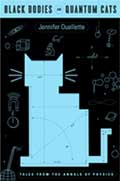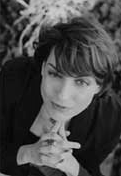Physics for the Rest of Us
 If you're among the many who hark back to high school physics classes with a visceral shudder or with a smug "I was right; in 'real life,' I never did use what I learned" -- Jennifer Ouellette wants to talk to you.
If you're among the many who hark back to high school physics classes with a visceral shudder or with a smug "I was right; in 'real life,' I never did use what I learned" -- Jennifer Ouellette wants to talk to you.
Ouellette, the author of Black Bodies and Quantum Cats: Tales From the Annals of Physics (Penguin) and associate editor for the American Physical Society, has made it her mission to show that physics is applicable to everyday life and that the math-centric science is nothing to be afraid of.
"There's physics in everything -- we don't exist in a vacuum," she recently told BTW. "There is no shortage of examples, and no need to be abstract and removed from reality."
 Jennifer Ouellette |
Black Bodies and Quantum Cats bears out that assertion: Each of its 38 chapters draws upon history from medieval to recent, and culture from foreign to pop. It's a masterful mix of theory and practice, facts and fun stuff, and the result is a highly readable text that will teach readers about physics in a manner that goes beyond useful to enjoyable and memorable.
Ouellette credits her Washington, D.C. writers' group with providing feedback that was instrumental in helping to shape the book. The members of the group are "all very bright, and not very interested in physics," she said. "The first thing I submitted was the microscope chapter [called 'Lens Crafters'], and I asked what it would it take to get them to read about physics."
Her question initially was met with skepticism, but Ouellette won the group over. She recalled, "A woman who said 'you'll never get me to read physics' loved two of the chapters and told me 'I really enjoyed them. I feel smart!'"
And that, emphasized Ouellette, was one of her goals in writing Black Bodies and Quantum Cats -- to place physics in the context of its fascinating history, to reveal the passions and personalities of physicists throughout history in such a way that even science-phobes could become interested in physics. "My goal is to reach people who resist, who were turned off by high school physics courses."
She added, "I didn't want to make it 'Physics for Dummies.' I don't accept that, just because people are English majors and can't do the math, they are idiots. They're not. I wanted to avoid a tone of condescension."
Ouellette herself was a college English major. "I came in through the back door of science writing: most people have science degrees and learn how to write. I'm the opposite ... and I skipped senior year of high school, so I never had physics."
Yet, the author said, through her job at the American Physical Society, she discovered a passion for the science, and a confidence in her ability to grasp concepts and explain them to her audience. However, when writing Black Bodies and Quantum Cats, she realized that "it's much harder to write for a general audience than for physicists. I had to remember what it was like to be a layperson.... I ended up with a deeper appreciation for physics, myself."
This appreciation shines through in Black Bodies and Quantum Cats as Ouellette describes the determination of Galileo, the ruthlessness of Thomas Edison, the dedication of Eimer of Malmesbury -- one of the author's favorite people from the annals of physics history. The Benedictine monk jumped from the rooftop of his abbey in an attempt to fly. (He broke both legs, but he did glide for 600 feet before crash-landing.) "That he would just jump off the roof," Ouellette said with a laugh, "now that's commitment."
Ouellette said she has a soft spot for Nikola Tesla, a 19th-century inventor who was crucial to the development of AC power. "He was such a weird dude," she mused, "so far ahead of his time, so misunderstood, and far too idealistic for his own good."
Modern-day figures play a role in the book, too. Marvel Comics devotees will delight in discovering that arch-villain Magneto from the X-Men series is invoked in a chapter about electromagnetism, and David Auburn's play Proof exemplifies a longstanding anti-female bias in math and science. H.G. Wells' The War of the Worlds, author Terry Pratchett, and artist Jackson Pollock all pop up in different chapters -- and even Fabio is name-checked in a chapter about roller coasters (his 1999 mid-air run-in with a wild goose makes excellent fodder for an explanation of gravity, acceleration, and g-forces).
When it comes to the role of women in physics, and the role of physics in education, Ouellette is nothing short of forceful: "There needs to be a real sea-change in physics education for non-majors. We're lagging so far behind the rest of the world in science and technology education, and we focus only on gifted students. We can no longer afford to ignore the others."
And, she noted, "One of the nice things about going to physics meetings is that there is never a line for the ladies' rooms ... It's true! The numbers are just so skewed. It's still very much a white male enclave, though that is slowly changing."
When she's not attending physics meetings, Ouellette will be promoting Black Bodies and Quantum Cats. In the works are visits to New York City, Washington, D.C., San Francisco, Austin, and Baltimore. She said, "I'm still lining things up -- if I'm going to be in a city and a store wants me to show up, I will."
Ouellette also is writing her second book for Penguin, The Physics of the Buffyverse, which uses characters and plotlines from the popular TV series Buffy, The Vampire Slayer to illustrate key aspects of advanced physics. The author noted, "The marketing for the two books will be very different. Buffyverse is dedicated to the fandom, and those people are loyal. Black Bodies and Quantum Cats will be a tougher sell because people resist the whole notion of physics."
However, Ouellette said, based on her personal experience, she has hope for a broader appreciation of her favorite area of science: "Once I figured out not to be afraid of physics, I realized it's not as scary or as difficult as people think." And about writing Black Bodies and Quantum Cats, she added, "I learned a lot about communicating with non-scientists. I want to be able to feed into the next generation of science writers just getting their degrees, who will take science writing to the next level."
After all, she said, "The message is that physics is not scary, this book is not scary -- it should be fun! Like Tesla, I have my idealistic side ... and I believe it's important we understand physics." --Linda M. Castellitto

